Having fresh mint around the house during the spring and summer is so nice, but most types of mint come with quite a few pests and issues that can cause the plant to turn brown.
Mint leaves can turn brown due to improper watering, pests, and fungal infections. Other likely reasons could be nutrient deficiencies, heat scorching, limited space, or aging.
The earlier you take care of these problems, the better chance that you have of saving your plant.
If your mint leaves are turning brown, here are some common causes and pests that might be impacting your plant.
Over Watering & Poor Drainage

Watering can be a challenge when you’re a new gardener, but even experienced gardeners can encounter this. Poor drainage causes the plant’s roots to essentially drown in the water that stays in the container. An overwatered plant can lead to root rot, yellowing or brown leaves, and weak stems.
Underwatering deprives the mint of getting enough moisture to properly supply life to itself. Too much water removes the oxygen needed to “breathe” properly.
Overwatered mint causes the leaves to turn yellow, and potentially turn brown if the problem persists.
Underwatered Mint Plant
Mint, as with any herb or vegetable needs a good amount of water to grow and thrive. When a plant doesn’t get enough water, it can wilt and turn brown or yellow.
The fix is easy, you just need to water it and stay on top of future watering. Don’t drown the plant and try and overdo it, that could make the problem worse.
You want to the soil to be moist, but not soaked. Moist soil is critical for proper growth and getting a large harvest from your mint plant.
Heat & Sunlight
Although many plants enjoy full sun, mint plants prefer shadier areas to grow in. While mint does need some direct sunlight to thrive as it grows, too much sun can cause issues. Giving mint some shade during the day allows it to spread quickly and thrive.
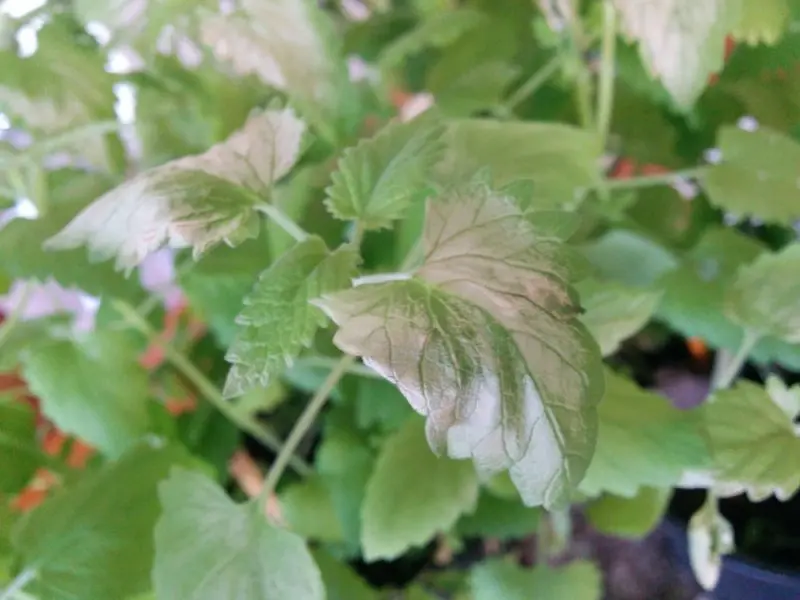
What Mint Sunscald Looks Like
Getting too much sunlight can burn the plant and cause the tips of the leaves to turn white and brown.
Temperature can also affect your mint, and if it’s too hot, a similar browning issue may be caused by too much heat or very cold weather.
If you do keep your mint plant in full sun, you’ll want to check on it and provide more water than you would if it were in part shade.
You can also use shade cloth to help reduce the amount of sunlight your plants are getting on those really hot days.
Constricted Roots
Constricted roots happen when a plant’s root outgrows the pot or container it’s living in and the roots don’t have enough space. This is really only an issue with potted plants and indoor mint plants. If your plant is in the ground, the roots will have plenty of space.
When roots can’t find enough space, they end up wrapping up in circles trying to find a place to go. At times, the roots may tangle, create knots and tightly crossed patterns.
All of these variations result in the roots having their flow constricted and create what are called “rootbound” plants. Rootbound plants require a larger container or pot to more freely move around in.
Having roots constricted prevents your mint from grabbing water and nutrients present in the soil that keep the plant alive.
What Constricted Roots Look Like
Rootbound plants are pretty easy to identify. If you see roots starting to shoot out of the drainage holes in the bottom of the container, that can be a decent sign that this is happening.
Once you remove the plant from the container, you’ll see roots that look like one of these two:
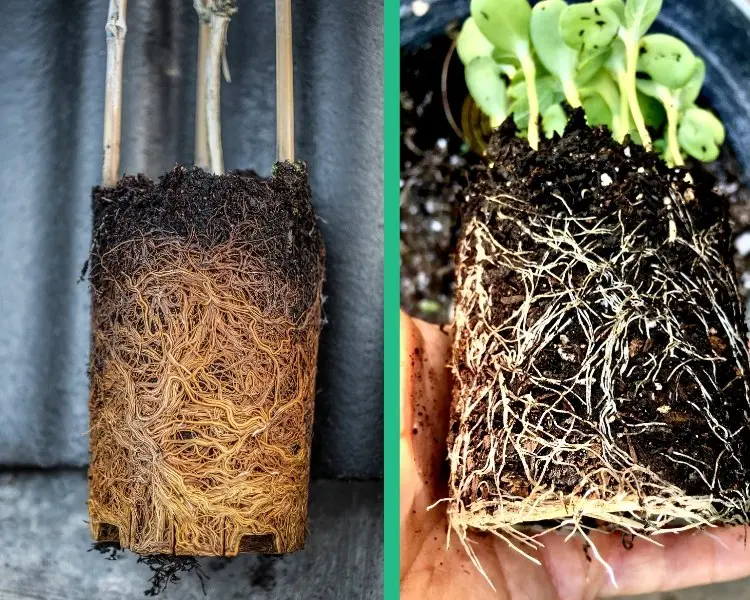
Now these are extreme examples, but if you see anything like that you’re going to want to transplant your mint plant into a larger container.
Leaves generally turn yellow first when this happens, but the leaves and turn brown from being rootbound and having compacted soils.
How to Fix It
Repotting your plant and moving it to a larger container is the best option here. Since roots are out of room to grow, they will eventually start to choke themself out and eventually cause the plant to die.
If you have multiple plants growing in one container, this would be a good time to separate them and plant them in their own pots with fresh soil.
Pests on Mint Plants
There are a number of pests that can decimate your mint plant and cause the mint leaves to start turning brown.
Spider Mites
Spider mites are pretty gross looking. They feed on the juice of the plants and can weaken or eventually kill the plant completely. At first, you’ll see specs of damage on the leaves, but if you have a severe infestation you’ll notice more discolored or browning leaves.
What it Looks Like
If you start to see what looks like cobwebs on your plant, you likely have a spider mite problem. Catching them early is ideal because they can quickly spread, lay eggs, and turn into something like this:
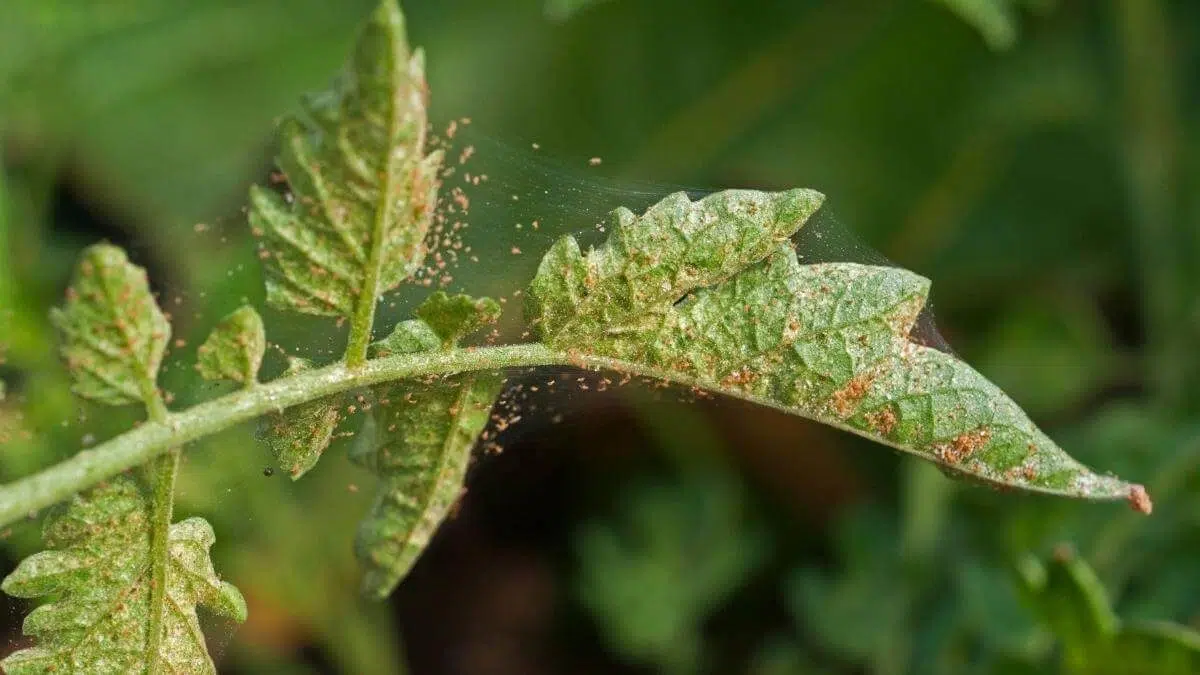
How to Fix It
Spider mites like dry, hot weather, so if your mint plant is in the sun, you can move it to a more shaded location to make this plant less than ideal for them.
You can spray water on them with a stronger setting on your hose nozzle, like a “jet” or “center” setting. You’re essentially just spraying off all of the bugs.
Companion planting mint near daisies and carrots is a great idea. These two types of plants attract predatory insects for spider mites and can help reduce any infestation.
Aphids
Aphids come in all colors, so this might be a little harder to recognize up front.
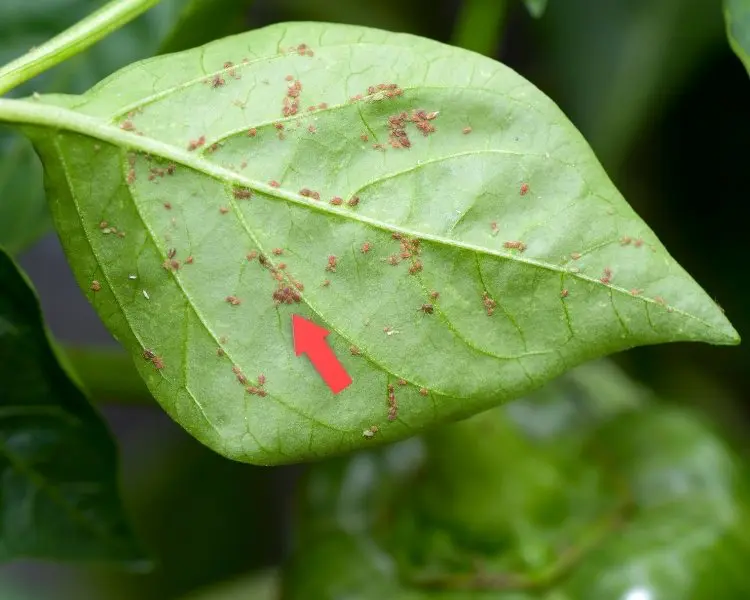
What Aphid Damage Looks Like
Aphids tend to appear on the bottom side of leaves or stems, which is also where the females will lay eggs.
When mint aphids (ovatus crataegarius) are overpopulated, they damage the plant leaves with large amounts of a sticky, brown or clear liquid on the leaves called honeydew. Honeydew can attract fungal diseases to the plant such as sooty mold.
How to Get Rid of Aphids
Neem oil is a great way to get rid of a lot of soft-bodied insects, and aphids are no exception.
Four Lined Plant Bug
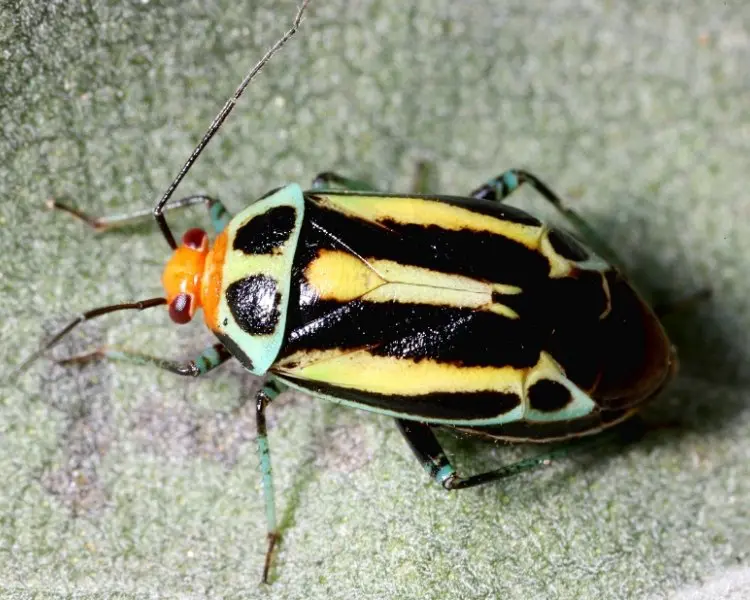
Poecilocapsus lineatus
Four-lined plant bugs love herbs in the mint family, so it’s no surprise that your mint plant itself could be impacted.
Four-lined plant bug eggs start to emerge as nymphs in the spring. They feed on the top side of leaves and then become adults.
Eggs are banana-shaped and are in vertical lines along the plant’s stem.
What It Looks Like
The four-lined plant bug will feed on the leaves, and cause very dry, brown spots to appear. This pest can move quickly and cause a ton of damage in just a few hours.
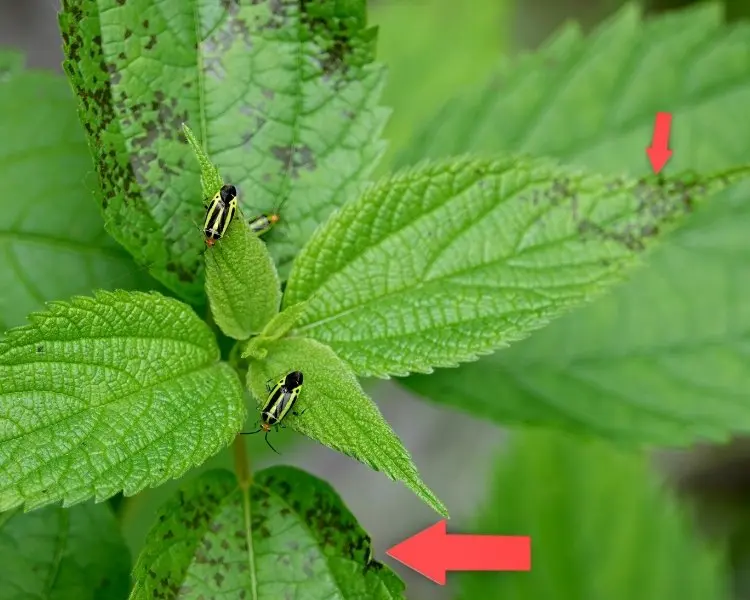
At first, the spots will look dark green, almost like a green glitter was sprinkled on your plant. After a few hours or days, the spots will turn brown and dry out.
The females lay their eggs on the top 4-5 inches of the plant, so it should be easier to find them once you realize they are there.
How to Fix it
Regularly keep an eye out for four lined bugs on your plants. As mentioned before, they can cause excessive damage quickly so if you catch it early, you can save your plants. While most damage is cosmetic, I wouldn’t eat the damaged leaves.
After the season ends, remove damaged plants after each season making sure to cut back any plants to avoid eggs from making it through the winter.
Fungal Diseases
Mint Rust
Mint rust is a common problem that causes brown mint leaves. Mint rust is caused by too much humidity around the leaves, which often happens when your mint leaves stay wet for too long.
What Mint Rust Looks Like
Mint rust appears as brown spots on the leaves of your mint plant. Oftentimes these spots are surrounded by a yellow ring which is where the newer infected part of the leaf is.
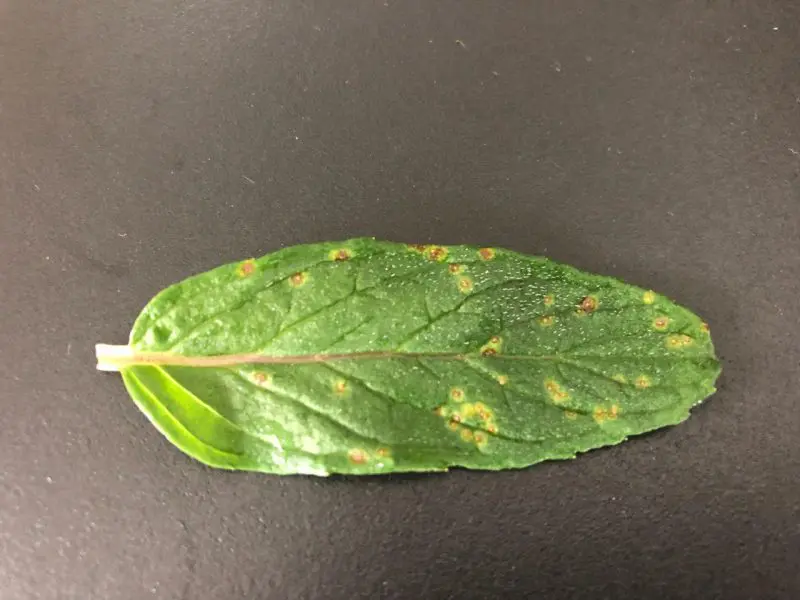
How to Prevent Mint Rust
You can prevent mint rust by watering your plants from the bottom. While it might be easier, overhead watering gets the leaves wet and can attract fungus if they don’t dry properly throughout the day.
Allow for proper air circulation between your mint plants. If you plant them too close, you provide a better environment for a fungal disease to thrive.
How to Fix Fungal Rust
If you suspect rust and it is taking over your plant, you’ll want to take action quickly.
To fix mint rust fungus from completely ruining your plants, cut off the leaves of your infected mint plant that have rust spots. Do not eat these leaves as they are infected with a fungal disease you do not want to ingest.
Leaf Blight
Cephalosporium sp.
Blight is not one particular disease, but a variety of them that can affect almost any plant. Blight might kill the entire plant, or it will cause stunted growth.
Generally impacts the main stem of the plant but can also show up in the bottom leaves.
What Leaf Blight Looks Like
Leaf blight first appears on the lower, more mature leaves in a bull’s eye pattern of small brown spots with rings around them. If left for too long, the plant will being to turn yellow and can die.
How to Fix It
You can use a copper fungicide to get rid of blight and other issues like powdery mildew.
You also want to always clean your pruning shears between uses and even between plants to avoid spreading fungal diseases.
Tomato Spotted Wilt Virus
Yes, this belongs on a list of mint problems, trust me. The name might be deceiving, but it is spread by thrips, which are a common pest of the mint plant. Thrips spread the disease which can begin on your tomato plants or other types of crops like grapes, strawberries, and even soybeans.
This will cause brown mint leaves or even leaves that are orange in color. Leaves eventually start to look silvery or even black which is caused by the thrips’ fecal matter.
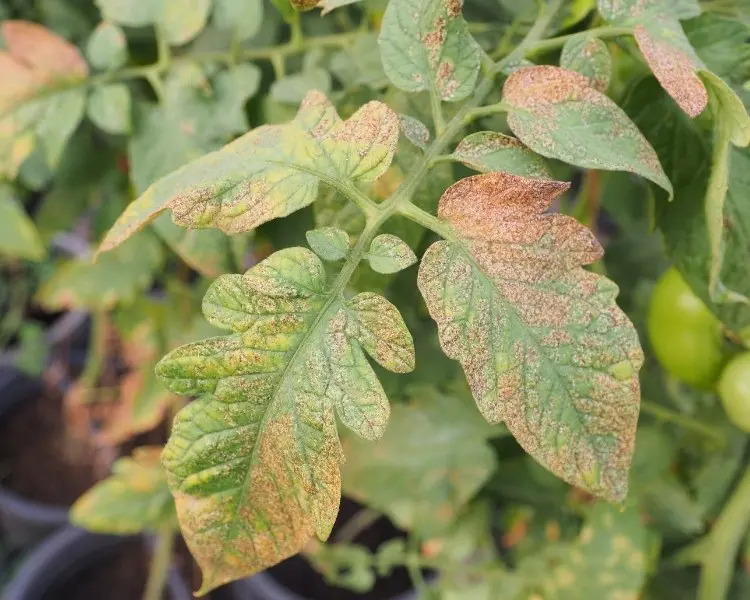
How to Fix It
Prune all damaged leaves and spray the plant with a mixture of 2 teaspoons of soap to a gallon of water.
This garden spinosad spray is quite effective in killing thrips, caterpillars and leaf miners.
How to Prevent It
Thrips are the bugs that transfer this virus to mint from tomatoes. Thrips can be hard to prevent, but row covers often help. Just make sure you’re not placing row covers over a crop that already has an infestation, as you’ll just trap them in there and make matters worse.
Can You Eat Brown Mint Leaves?
If your plant is infected with mint rust or another fungal disease, you should not be eating the leaves. If the leaves are brown from sunburn, it might not be harmful to eat, but they also might taste quite weird.
Pruning your mint plant to remove the brown leaves can help your plant grow healthier over time.
None of us want our mint leaves to turn brown, but if you do encounter brown leaves, at least you’ll have some guide to determining the cause and how to fix the problem.




The photos of what can go wrong with mint are great. Thank you for doing this.
Very informative and I truly appreciate the photos for help with identifying the problem. I have had no problems with any of my various mints until this year. Our weird weather, and such I believe to be a big culprit. I have scaled back on gardening due to my inability to be on top of the many things that are going wrong with my plants this year. Very frustrating.